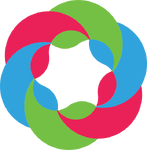Adamdzarif (talk | contribs) (Adding categories) Tag: categoryselect |
No edit summary |
||
| (23 intermediate revisions by 12 users not shown) | |||
| Line 1: | Line 1: | ||
| − | {{ImageTOC |
+ | {{ImageTOC |
| + | |Paralympic 1988.svg|1988–1994 |
||
| − | |image1=Paralympic_1988.png|head1=1988-1994 |
||
| + | |Paralympic 1994.svg|1994–2004 |
||
| − | |image2=Paralympic_1994.png|head2=1994-2003 |
||
| + | |Paralympics.svg|2004–2019 |
||
| − | |image3=IPC Logo.png|head3=2003-present}} |
||
| + | |Paralympics_2019.svg|2019–present |
||
| + | }} |
||
| + | ==1988–1994== |
||
| + | [[File:Paralympic 1988.svg|center|250px]] |
||
| ⚫ | This was first used as the logo for the [[Seoul 1988#Paralympics|Seoul 1988]] games; the first Paralympics held in tandem to the Olympics in the same city since 1964. The International Olympic Committee deemed this logo too similar to the Olympic Rings to serve as the International Paralympics Committee logo and requested that it be changed. |
||
| + | <gallery position="center" widths="150" captionalign="center" bordercolor="transparent" hideaddbutton="true"> |
||
| + | Paralympics_1991unused.svg|Rejected design<br>(1991) |
||
| + | </gallery> |
||
| + | ==1994–2004== |
||
| + | [[File:Paralympic 1994.svg|center|200px]] |
||
| ⚫ | This logo takes inspiration from the former, taking the number of segments down to 3. The colours red, green and blue were chosen as they are the three most commonly used colours on national flags. It was used from the [[Lillehammer 1994#Paralympics|Lillehammer 1994]] winter games up to the [[Athens 2004#Paralympics|Athens 2004]] summer games when the new logo had already officially taken effect. |
||
| + | ==2004–2019== |
||
| + | [[File:Paralympics.svg|center|200px]] |
||
| ⚫ | This logo is derived from the latin term Agitos which means "I move". The three ticks encircle a singular point, symbolising motion and the meeting of athletes from across the globe for competition. This logo was presented at the closing ceremony of the Athens 2004 Paralympic Games and it was first used on a game emblem during the [[Torino 2006#Paralympics|Torino 2006]] winter games. |
||
| + | <gallery position="center" widths="150" captionalign="center" bordercolor="transparent" spacing="small" hideaddbutton="true"> |
||
| + | Paralympics Black.svg|Print variant |
||
| + | Paralympic_2004IPC.svg|International Paralympic Committee variant |
||
| + | Paralympic_2004IPCPrint.svg|International Paralympic Committee print variant |
||
| + | Paralympic_2004IPCShorthand.svg|IPC variant |
||
| + | Paralympic_2004IPCShorthandPrint.svg|IPC print variant |
||
| + | </gallery> |
||
| − | == |
+ | ==2019–present== |
| + | [[File:Paralympics_2019.svg|center|200px]] |
||
| ⚫ | |||
| + | On the 20th October 2019, the International Paralympic Committee refreshed the look of the Agitos. This change comes the day before the emblems for the [[Paris 2024]] games were revealed. |
||
| − | Paralympic_rejected_1991.png|Logo unveiled in 1991. This design was rejected. |
||
| + | <gallery position="center" widths="150" captionalign="center" bordercolor="transparent" spacing="small" hideaddbutton="true"> |
||
| + | Paralympics_2019print.svg|Print variant |
||
| + | Paralympics_2019IPCFull.svg|International Paralympic Committee variant |
||
| + | Paralympics_2019IPCFullPrint.svg|International Paralympic Committee print variant |
||
</gallery> |
</gallery> |
||
| ⚫ | |||
| − | ==1994-2003== |
||
| ⚫ | |||
| − | |||
| − | ==2003-present== |
||
| − | [[File:IPC Logo.png|centre|thumb|220x220px]] |
||
| ⚫ | |||
| ⚫ | |||
[[Category:Symbols]] |
[[Category:Symbols]] |
||
| ⚫ | |||
| ⚫ | |||
[[Category:Sports]] |
[[Category:Sports]] |
||
| − | [[Category: |
+ | [[Category:Sports competitions]] |
| + | [[Category:International sport federations]] |
||
| + | [[Category:Paralympics]] |
||
| ⚫ | |||
| ⚫ | |||
Revision as of 08:39, 5 November 2019
| 1988–1994 | 1994–2004 | 2004–2019 | |
| 1988–1994 | 1994–2004 | 2004–2019 | 2019–present |
1988–1994
This was first used as the logo for the Seoul 1988 games; the first Paralympics held in tandem to the Olympics in the same city since 1964. The International Olympic Committee deemed this logo too similar to the Olympic Rings to serve as the International Paralympics Committee logo and requested that it be changed.
1994–2004
This logo takes inspiration from the former, taking the number of segments down to 3. The colours red, green and blue were chosen as they are the three most commonly used colours on national flags. It was used from the Lillehammer 1994 winter games up to the Athens 2004 summer games when the new logo had already officially taken effect.
2004–2019
This logo is derived from the latin term Agitos which means "I move". The three ticks encircle a singular point, symbolising motion and the meeting of athletes from across the globe for competition. This logo was presented at the closing ceremony of the Athens 2004 Paralympic Games and it was first used on a game emblem during the Torino 2006 winter games.
2019–present
On the 20th October 2019, the International Paralympic Committee refreshed the look of the Agitos. This change comes the day before the emblems for the Paris 2024 games were revealed.










